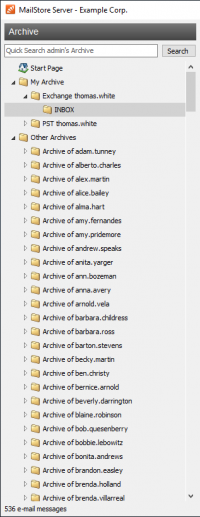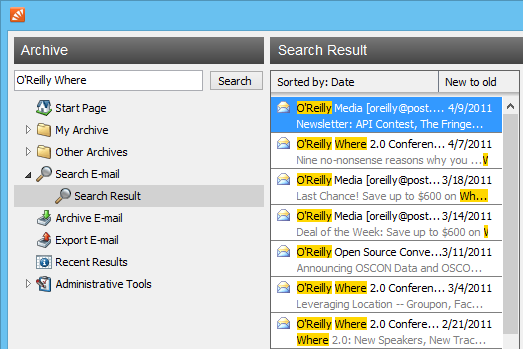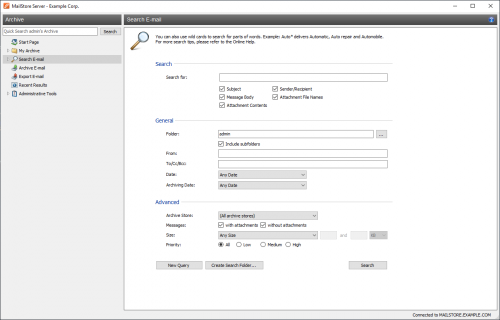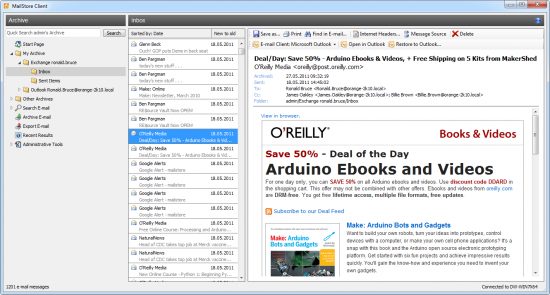Difference between revisions of "Accessing the Archive with the MailStore Client software"
| [unchecked revision] | [unchecked revision] |
| Line 218: | Line 218: | ||
[[File:accs_openclient_01.png|center|450px]] | [[File:accs_openclient_01.png|center|450px]] | ||
| + | |||
| + | Depending on the selected email client, additional button may be visible: | ||
* '''Open in <email client>''' - Open the current message to the selected email client. Please note, that emails are simply opened, not stored, in the application. To restore emails to an email application, please use MailStore's Export Feature. | * '''Open in <email client>''' - Open the current message to the selected email client. Please note, that emails are simply opened, not stored, in the application. To restore emails to an email application, please use MailStore's Export Feature. | ||
Revision as of 12:58, 1 June 2011
Installation
The MailStore Client setup file that matches your MailStore Server version is stored the MailStore Server machine. Follow the Install MailStore Client on other Computers link on your desktop and copy the corresponding setup file to the client computer.
It is a regular Windows setup program, that can by executed on the appropriate client computer by double-clicking on the setup file. Just follow on-screen instructions.
Notice: Alternatively to installing the MailStore Client application manually, you can also deploy it to the client computer though the Active Directories Group Policy feature. More information on that can be found in the article MailStore Client Deployment
Starting and Login
Start MailStore Client by using the appropriate link on the desktop. The login window appears.
Put the IP address or hostname of the MailStore Server machine into Server Name. Be aware, that the pre-filled entry localhost only works if the MailStore Client is run from the same machine where MailStore Server is installed.
Enter the username and password of a MailStore administrator (admin) or a normal MailStore user into the User Name and Password fields and click OK. You may be asked to trust the MailStore Server; click OK here.
Important notice: As long as you have not changed the default administrator password (admin), you will not be able to login from any other machine with the username admin.
Searching by Folder Structure
MailStore stores all archived emails in a MailStore-specific folder structure, in which emails are displayed using the same structure as their corresponding source application. This means that folders created in the source application (e.g. Microsoft Outlook) are not changed during the archiving process and can be found easily in MailStore as well.
User Archives
For every user, MailStore creates a folder called My Archive on the highest level of the folder structure. Each folder corresponds to the user archive of the respective user and contains all his or her emails.
If the user has access to the archives of other users, their folders are listed as Archive of <User Name> under the top level folder Other Archives.
Viewing the Emails in a Folder
To view the emails in a folder, simply click on the folder name. The emails will be listed below the folder structure.
Click on the text Sorted by: <value> to change the order in which emails are displayed. Emails can be sorted according to:
- Date
- From/To (sender/recipient of the email)
- Subject
Click on the Field to the right of Sorted by ("New to Old" in the screenshot) to reverse the order in which emails are arranged. By default, the latest email is displayed first.
Refreshing the View
To refresh the list of folders, click on a folder and press F5 on your keyboard.
Click on the folder again to refresh the list of emails.
Creating, Renaming and Deleting Folders
Information about how to create, rename and delete folders is available in the chapter The MailStore Folder Structure.
Quick Search
With MailStore's integrated quick search feature, users can browse through all emails in all user archives they have access to. Quick search is especially suitable for simple queries. Alternatively, an Extended Search can be used.
Using Quick Search
Quick search is located in the upper left area of the application window. Simply enter one or more keywords into the search field and click on Search or press Enter. Search results are displayed in the column right of the folder list. If a keyword appears in the header or the subject line, it is highlighted.
Searching for Word Fragments
To view all emails containing a particular word fragment, use the wildcard character ( * ). For example:
auto*
would locate "auto", "automatic", "automobile" and others.
Searching for Phrases
To search for words appearing consecutively and in a certain order, use quotation marks ( "" ). For example:
"Microsoft Windows"
would only locate Microsoft Windows, not Microsoft Works or Windows 95.
Narrowing by Fields
A search for keywords or phrases can be limited to particular fields. For example:
subject:News only in Subject from:[email protected] only in From to:[email protected] only in To cc:[email protected] only in Cc bcc:[email protected] only in Bcc
Excluding Words
To narrow a search, it may be desired to specify words that must NOT be present in the emails. To exclude keywords from the search results, simply place a minus ( - ) sign in front of them. For example:
ZDNet -download-hint
would locate all emails from ZDNet, but not download-hint.
Combining Search Options
The search options described above can also be combined. For example:
ZDNET -"Daily Update"
would locate all emails from ZDNet which do not contain the consecutive words Daily Update.
Extended Search
With MailStore's integrated extended search, complex search processes can be carried out. Not only can the email content be searched but also parameters such as date and email size.
Using the Extended Search
In the MailStore application window, click on Search Email. Specify the search criteria for the emails that are to be included in the results. The criteria are AND-connected, meaning that the search results include only those emails that satisfy all criteria specified. Click on Search to start the search.
Search Criteria under "Search"
Enter a keyword or phrase into the text field, and specify where MailStore is to direct the search.The following options are available:
- Subject - The subject line of the email is searched.
- Sender/Recipient - The fields "From", "To", "Cc", and "Bcc" are searched.
- Message body - The text-only or HTML sections of the email are searched (depending on availability).
- Attachments File Names - The file names of the email attachments are searched.
- Attachment Contents - The contents of the email attachments are searched. If and to what extent attachments can be searched depends on the indexing options specified (under Administrative Tools).
In the textfield Search for, all options described in section Quick Search, such as phrases and wildcards, are available here as well.
Search Criteria under "General"
Under General, the following options are available:
- Folder - The folder to be searched by MailStore can be selected here. By default, this is the main folder of the current user. By clicking the button to the right of the text field, folders can also be selected using the folder structure. As administrator, the folders of all users can be searched.
- Include subfolder - If selected, MailStore not only searches the selected folder (e.g. Inbox), but all subfolders created therein (e.g. Inbox / Projects 2008 / Profit Optimization) as well.
- From - Any keywords or email addresses entered here are searched for only within the email's sender field.
- To/Cc/Bcc - Any keywords or email addresses entered here are searched for only within the email's recipient fields.
- Date - The timeframe the search is to cover can be selected here. Either a predefined range, such as Yesterday or This year, can be selected or, by choosing Custom, a specific period can be specified manually. In this case, the start and end dates will be included.
In the fields From and To/Cc/Bcc, all options, such as phrases and wildcards, described in section Quick Search are available.
Search Criteria under "Advanced"
Under Advanced, the following options are available:
- File Group - If the archive consists of more than one file group, the search can be limited to just one of the. By default all file groups are searched.
- Messages with/without attachments - By default, all messages are searched, regardless of whether or not they have any file attachments. Clear one of the check boxes to remove certain emails, such as those without attachments, from the results.
- Important: These searches can be imprecise at times because items like background pictures could be regarded as attachments.
- Size - By default, all messages are searched regardless of their size. Use the appropriate fields provided to limit the search according to the size of the emails, e.g. at least 5 MB or between 400 and 600 KB.
- Priority - Emails are searched according to the priority level of the email as assigned by the sender. When choosing Low, all emails with a priority level lower than Normal are returned, when choosing High, all emails with a priority level higher than Normal are returned. Emails not containing any information regarding priority are assumed to have a priority level of Normal.
Starting the Search
Click on Search to start the search. Results are displayed in a list in the left section of the main window.
Refining the Search Results
Click on Search Email again to further narrow the results after a search has been executed. Specify any additional search criteria and click on Search once more.
Starting a New Search
Click on New Query to start a new search. All search criteria will be reset to their default values (i.e. an unrestricted search of the folders of the current user).
Saving Search Criteria for Reuse
Search criteria that are used repeatedly (such as "all receipts from last month") can be saved and reused at a later time: Click on Create Search Folder... and provide a meaningful name for the search.
The new search folder will be available under the Search Email folder on the left side of the application window.
To modify a search folder, right click on the corresponding folder under Search Email on the left side of the application window and select New Search Query. After modifying the search criteria, click on Create Search Folder... and save it under the same name again.
To rename or delete a search folder, right click on on the corresponding folder under Search Email on the left side of the application window and click on the appropriate entry.
Email Preview
MailStore offers an integrated email preview displaying emails the same way as standard email applications. To activate the preview, simply click on an email or use the arrow keys to highlight the desired email in the list.
The menu bar above the email preview shows all functions available for the email currently displayed.
Save as...
Click on Save as... to save the current email in any Windows folder. Emails can be saved in the following file formats:
- RFC822 EML - These files can be opened independently from MailStore by double-clicking and can be moved to applications such as Outlook Express by drag & drop.
- Outlook MSG - These files can be opened with or imported to all versions of Microsoft Outlook (not Outlook Express) directly.
Using the print function, the email currently displayed will be printed including header information such as Date and Subject.
Find in Email
Click on Find in Email... to search the message body of the current email.
Internet Headers...
Click on Internet Headers to view the header of the current email, including all MIME parts.
Message Source
Click on Message Source to show the full source of the current message including all MIME-parts.
Delete (only with the appropriate privilege)
Click on Delete to delete the current email from the archive. Please keep in mind that, in order to use this function, the appropriate privilege has to be in place.
Reopening Emails in an Email Application
Emails previewed in MailStore can be reopened in any email application to reply to or forward them. Select an email client you want to open email messages in first, by clicking on Email Client:. MailStore only lists email clients that are supported and that are installed on the computer from which MailStore Client is executed.
Depending on the selected email client, additional button may be visible:
- Open in <email client> - Open the current message to the selected email client. Please note, that emails are simply opened, not stored, in the application. To restore emails to an email application, please use MailStore's Export Feature.
- Restore to <email client>... - Restore the current message to the selected email client. If further settings are required an additional button Settings.. will be shown.







